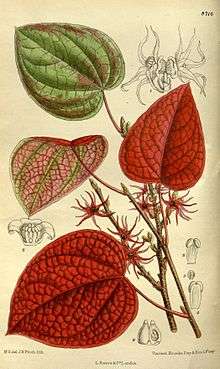Disanthus
| Disanthus | |
|---|---|
 | |
| D. cercidifolia (sic), Curtis's Botanical Magazine, 1917 | |
| Scientific classification | |
| Kingdom: | Plantae |
| (unranked): | Angiosperms |
| (unranked): | Eudicots |
| (unranked): | Core eudicots |
| Order: | Saxifragales |
| Family: | Hamamelidaceae |
| Genus: | Disanthus Maxim. |
Disanthus is a genus containing two species of flowering plants in the family Hamamelidaceae. The type species, Disanthus cercidifolius, was the only known species until 2017, when a second species, D. ovatifolius was described[1].
Disanthus cercidifolius is native to woodland habitats in China and Japan[2] while D. ovatifolius is found in northern Vietnam[1]
Nomenclature
The type species epithet was originally spelled D. cercidifolia.[3] The International Code of Nomenclature for algae, fungi, and plants stipulates that the Latin grammatical gender is masculine, and so the spelling is D. cercidifolius.[4] Disanthus ovatifolius was first introduced to horticulture in Europe under the invalid name Uocodendron whartonii, honoring the late Peter Wharton, formerly curator of the David C. Lam Asian Garden at UBC Botanical Garden in Vancouver. After scientific study, the new species was assigned to Disanthus.[1]
Description
Disanthus cercidifolius is a medium-sized deciduous shrub growing to 3 m (10 ft) tall and wide. It is noted for its heart-shaped leaves which turn to shades of red, purple and yellow in autumn.[5][6]
- Varieties
- Disanthus cercidifolius var. longipes — endemic to China.
Cultivation
Disanthus cercidifolius is cultivated as an ornamental plant. It is a calcifuge, requiring a lime-free soil.
The plant has gained the Royal Horticultural Society's Award of Garden Merit.[7]
References
- 1 2 3 Averyanov, Leonid V.; Endress, Peter K.; Quang, Bui Hong; Nguyen, Khang Sinh; Nguyen, Dzu Van (2017-06-02). "Disanthus ovatifolius (Hamamelidaceae), a new species from northwestern Vietnam". Phytotaxa. 308 (1): 104–110. ISSN 1179-3163. doi:10.11646/phytotaxa.308.1.9.
- ↑ Zhi-Yun Zhang, Hongda Zhang, and Peter K. Endress, "Disanthus Maximowicz, Bull. Acad. Imp. Sci. Saint-Pétersbourg. 10: 485. 1866", Flora of China
- ↑ Maximowicz, C. J. (1866), "Diagnoses breves plantarum novarum Japoniae et Mandshuriae/Courtes diagnoses des nouvelles plantes provenant du Japon et de la Mandchourie", Bulletin de l'Académie impériale des sciences de St.-Pétersbourg, series 3, volume 10: 485–490
- ↑ McNeill, J.; Barrie, F.R.; Buck, W.R.; Demoulin, V.; Greuter, W.; Hawksworth, D.L.; Herendeen, P.S.; Knapp, S.; Marhold, K.; Prado, J.; Prud'homme Van Reine, W.F.; Smith, G.F.; Wiersema, J.H.; Turland, N.J. (2012), International Code of Nomenclature for algae, fungi, and plants (Melbourne Code) adopted by the Eighteenth International Botanical Congress Melbourne, Australia, July 2011, Regnum Vegetabile 154, A.R.G. Gantner Verlag KG, ISBN 978-3-87429-425-6 Article 62.2(c)
- ↑ RHS A-Z encyclopedia of garden plants. United Kingdom: Dorling Kindersley. 2008. p. 1136. ISBN 1405332964.
- ↑ "Missouri Botanical Garden - Disanthus cercidifolius". Retrieved 18 June 2013.
- ↑ "RHS Plant Selector - Disanthus cercidifolius". Retrieved 18 June 2013.